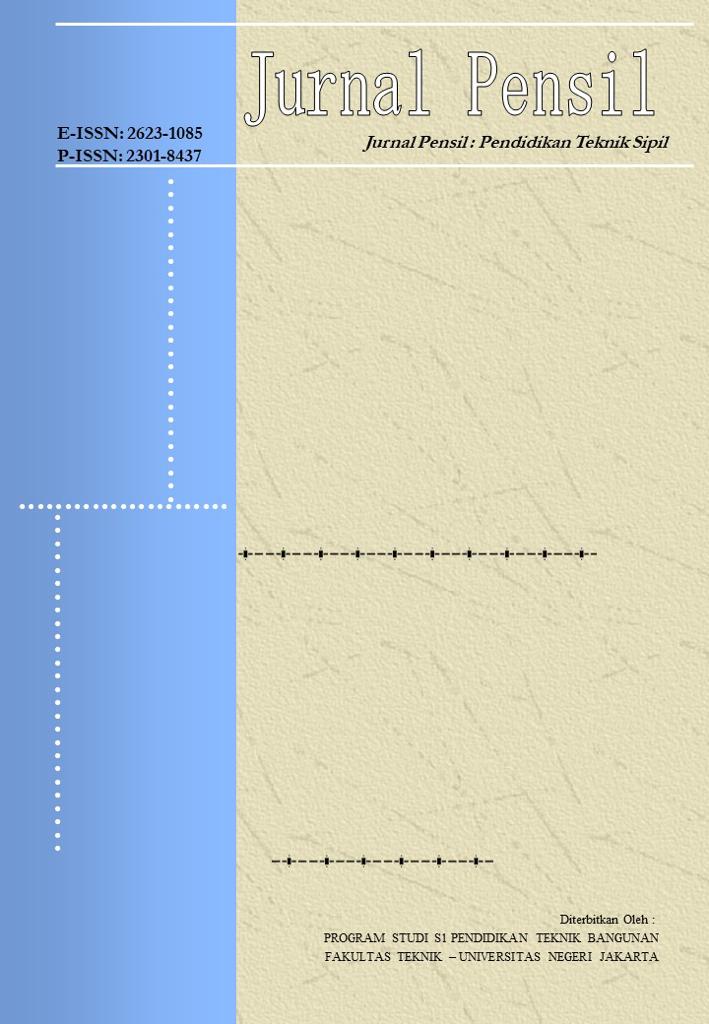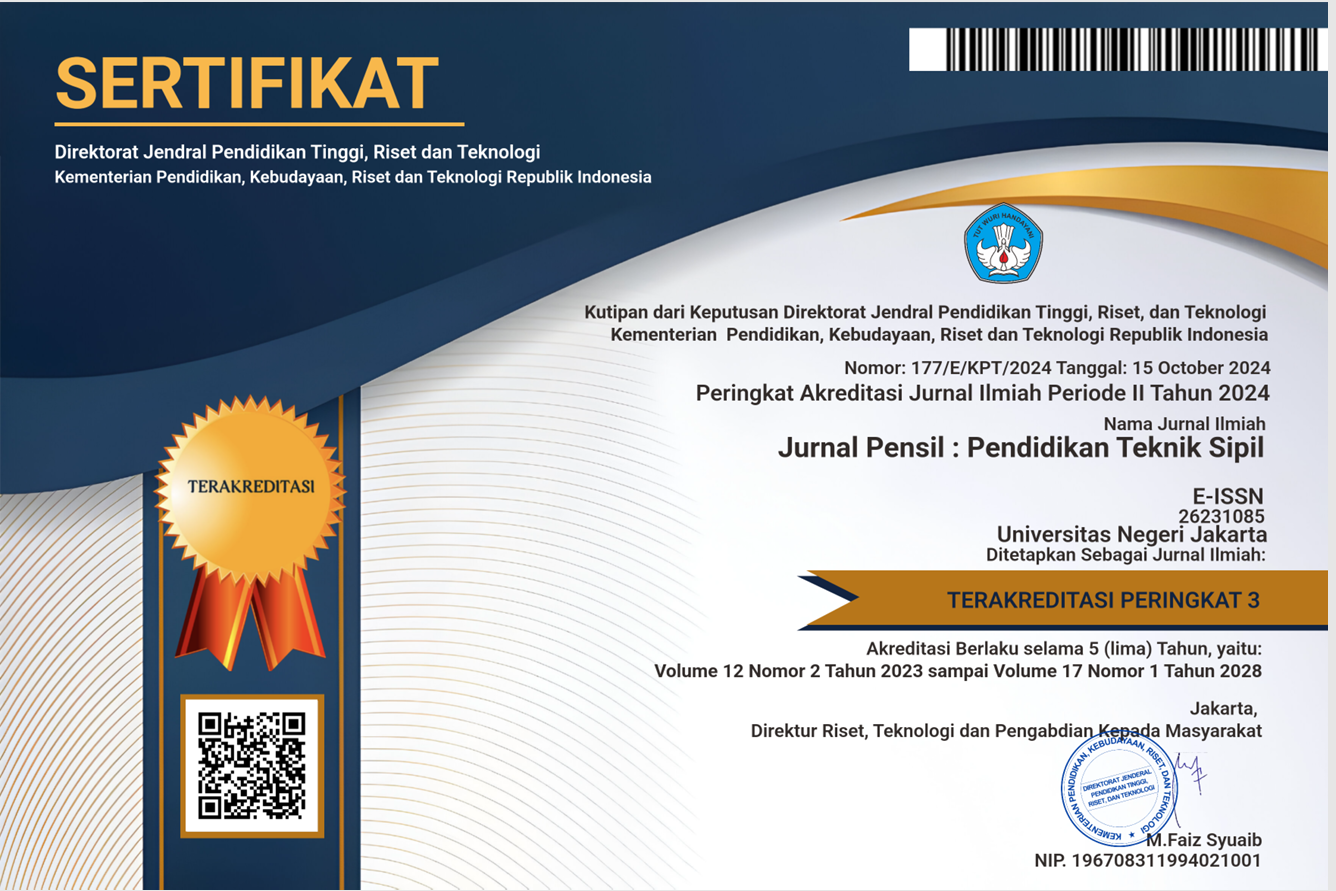SEISMIC RESPONSE IN MUARA BANGKAHULU SUB-DISTRICT, BENGKULU CITY, USING THE CONCEPT OF WAVE PROPAGATION
DOI:
https://doi.org/10.21009/jpensil.v13i3.45746Keywords:
Earthquake, Peak Ground Acceleration, Time History of Earthquake Acceleration, Amplification Factor, Acceleration Spectra ResponseAbstract
The position of Bengkulu Province, which is flanked by the subduction zone between the Euro-Asian and Indian-Australian plates to the west, and the Sumatra Fault zone to the east, makes Bengkulu City one of the areas prone to earthquake disasters. Muara Bangkahulu District is one of the sub-districts in Bengkulu City. Muara Bangkahulu sub-district is an area that functions as a government centre, trade and service centre, and one of the education centres in Bengkulu City. This study aims to determine the ground response in the Muara Bangkahulu sub-district area during an earthquake. The wave propagation method used in this study is a one-dimensional equivalent of linear and nonlinear modelling that propagates earthquake waves from bedrock to surface. The results of this study are Peak Ground Acceleration (PGA), amplification factor, earthquake acceleration time history, and acceleration spectra response. The results of this analysis will be compared between equivalent linear and nonlinear values. The results of this study can also help us realise and further consider the value of seismic design in the Muara Bangkahulu sub-district area, mainly if a stronger earthquake occurs in the future.
References
Adampira, M., Alielahi, H., Panji, M., & Koohsari, H. (2015). Comparison of equivalent linear and nonlinear methods in seismic analysis of liquefiable site response due to near-fault incident waves: a case study. Arabian Journal of Geosciences, 8(5), 3103–3118. https://doi.org/10.1007/s12517-014-1399-6
Anbazhagan, P., Aditya, P., & Rashmi, H. N. (2011). Amplification based on shear wave velocity for seismic zonation: comparison of empirical relations and site response results for shallow engineering bedrock sites. In Geomechanics and Engineering (Vol. 3, Issue 3).
Arros, J., & Doumbalski, N. (2013). Division V In-structure Seismic Acceleration Response Spectra Generated from Nonlinear vs. Linear Building Response Analysis. In Transactions.
Assimaki, D., & Kausel, E. (n.d.). An equivalent linear algorithm with frequency-and pressure-dependent moduli and damping for the seismic analysis of deep sites. www.elsevier.com/locate/soildyn
Badan Standarisasi Nasional. (2019). SNI 1726:2019: Tata Cara Perencanaan Ketahanan Gempa Untuk Struktur Bangunan dan Struktur Lain. Jakarta: Standar Nasional Indonesia.
Bozorgnia, Y., Eeri, M, & Campbell, K. W. (2016). Vertical Ground Motion Model for PGA, PGV, and Linear Response Spectra Using the NGA-West2 Database.
Bustari, A. A., & Wibowo, N. B. (2023). Pemetaan sebaran nilai Vs30, faktor amplifikasi tanah, dan peak ground acceleration wilayah Bantul timur. Cakrawala Jurnal Ilmiah Bidang Sains, 1(2). https://doi.org/10.28989/cakrawala.v1i2.1436
Chang, D. W., Cheng, S. H., & Wang, Y. L. (2014). One-dimensional wave equation analyses for pile responses subjected to seismic horizontal ground motions. Soils and Foundations, 54(3), 313–328. https://doi.org/10.1016/j.sandf.2014.04.018
Farid, M., & Mase, L. Z. (2020). Implementation of seismic hazard mitigation on the basis of ground shear strain indicator for spatial plan of Bengkulu city, Indonesia. International Journal of GEOMATE, 18, 199–207. https://doi.org/10.21660/2020.69.24759
Fathani, T. F., Adi, A. D., Pramumijoyo, S., & Karnawati, D. (2008). The Determination of Peak Ground Acceleration at Bantul Regency, Yogyakarta Province, Indonesia. The Yogyakarta Earthquake 2006, 12-1 - 12-15.
Finn, W. D., Lee, M. K., & Martin, G. R. (1978). Comparison of dynamic analyses for saturated sands. In Earthquake Engineering and soil dynamics (pp. 472-491). ASCE.
Haridhi, H. A., Setiawan, I., Octavina, C., Mahdi, S., & Balqies, C. P. (2023). Tsunami scenario triggered by the activity of the Mentawai Fault Zone offshore western Sumatra Island. E3S Web of Conferences, 447. https://doi.org/10.1051/e3sconf/202344701012
Hashash, Y. M. A., & Park, D. (2001). Non-linear one-dimensional seismic ground motion propagation in the Mississippi embayment. www.elsevier.com/locate/enggeo
Huang, D., Wang, G., Du, C., & Jin, F. (2021). Seismic Amplification of Soil Ground with Spatially Varying Shear Wave Velocity Using 2D Spectral Element Method. Journal of EarthquakeEngineering,25(14),2834–2849. https://doi.org/10.1080/13632469.2019.1654946
International Code Council. (2006). International building code. USA: International Code Council; 2006.
Kaklamanos, J., Baise, L. G., Thompson, E. M., & Dorfmann, L. (2015). Comparison of 1D linear, equivalent-linear, and nonlinear site response models at six KiK-net validation sites. Soil Dynamics and Earthquake Engineering, 69, 207–219. https://doi.org/10.1016/j.soildyn.2014.10.016
Kale, Ö., Akkar, S., Ansari, A., & Hamzehloo, H. (2015). A ground-motion predictive model for iran and turkey for horizontal PGA, PGV, and 5% damped response spectrum: Investigation of possible regional effects. Bulletin of the Seismological Society of America, 105(2), 963–980. https://doi.org/10.1785/0120140134
Kossobokov, V. G., & Nekrasova, A. K. (2018). Earthquake hazard and risk assessment based on unified scaling law for earthquakes: Altai–Sayan Region. Natural Hazards, 93(3), 1435–1449. https://doi.org/10.1007/s11069-018-3359-z
Kumar, A., & Baro, O. (2015). High Amplification factor for Low Amplitude Ground Motion: Assessment for Delhi. Disaster Advances Vol (Vol. 8, Issue 12).
Mase, L. Z. (2017). Liquefaction potential analysis along coastal area of Bengkulu province due to the 2007 Mw 8.6 Bengkulu earthquake. Journal of Engineering and Technological Sciences, 49(6), 721–736. https://doi.org/10.5614/j.eng.technol.sci.2017.49.6.2
Mase, L. Z. (2018). Reliability study of spectral acceleration designs against earthquakes in Bengkulu City, Indonesia. International Journal of Technology, 9(5), 910–924. https://doi.org/10.14716/ijtech.v9i5.621
Mase, L. Z., & Likitlersuang, S. (2021). Implementation of Seismic Ground Response Analysis in Estimating Liquefaction Potential in Northern Thailand. Indonesian Journal on Geoscience, 8(3), 371–383. https://doi.org/10.17014/ijog.8.3.371-383
Mase, L. Z., Agustina, S., & Anggraini, P. W. (2020). Seismic hazard microzonation of ground response parameters in Bengkulu City, Indonesia. IOP Conference Series: Earth and Environmental Science, 528(1). https://doi.org/10.1088/1755-1315/528/1/012051
Massinai, M. A., Amaliah, K. R., Lantu, L., Virman, V., & M, M. F. Ismullah. (2016). Analisis Percepatann Tanah Maksimum dan MMI di Wilayah Sulawesi Utara. SNF2016-EPA-33-SNF2016-EPA-36. https://doi.org/10.21009/0305020407
Misliniyati, R., Mase, L. Z., Irsyam, M., Hendriyawan, & Sahadewa, A. (2019). Seismic response validation of simulated soil models to vertical array record during a strong earthquake. Journal of Engineering and Technological Sciences, 51(6), 772–790. https://doi.org/10.5614/j.eng.technol.sci.2019.51.6.3
National Earthquake Earthquake Hazard Reduction Program. (1998). Recommended Provisions for Seismic Regulation for New Buildings and Other Structures 1997 Edition, FEMA 302, Washington, USA, 1998.
Partono, W., Irsyam, M., & Prabandiyani, S. (2013). Syamsul Maarif Aplikasi Metode HVSR pada Perhitungan Faktor Amplifikasi Tanah di Kota Semarang.
Parvez, I. A., Nekrasova, A., & Kossobokov, V. (2017). Earthquake Hazard and Risk Assessment Based on Unified Scaling Law for Earthquakes: State of Gujarat, India. Pure and Applied Geophysics, 174(3), 1441–1452. https://doi.org/10.1007/s00024-017-1475-4
Pehlivan, M., Rathje, E. M., & Gilbert, R. B. (2016). Factors influencing soil surface seismic hazard curves. Soil Dynamics and Earthquake Engineering, 83, 180–190. https://doi.org/10.1016/j.soildyn.2016.01.009
Perrone, D., Brunesi, E., Filiatrault, A., & Nascimbene, R. (2020). Probabilistic estimation of floor response spectra in masonry infilled reinforced concrete building portfolio. Engineering Structures, 202. https://doi.org/10.1016/j.engstruct.2019.109842
Pribadi, S., Puspito, N. T., Rahman, M. S. S., & Tristanawati. (2016). Earthquake source characterization for tsunami zoning (Case study of the Bengkulu 12 September 2007 tsunami and the 2 June 1994 Banyuwangi tsunami). AIP Conference Proceedings, 1730. https://doi.org/10.1063/1.4947383
Puteri, D. M., Affandi, A. K., Sailah, S., Hudayat, N., & Zawawi, M. K. (2019). Analysis of peak ground acceleration (PGA) using the probabilistic seismic hazard analysis (PSHA) method for Bengkulu earthquake of 1900 - 2017 period. Journal of Physics: Conference Series, 1282(1). https://doi.org/10.1088/1742-6596/1282/1/012054
Qodri, M. F., Mase, L. Z., & Likitlersuang, S. (2021). Non-linear site response analysis of bangkok subsoils due to earthquakes triggered by three pagodas fault. Engineering Journal, 25(1), 43–52. https://doi.org/10.4186/ej.2021.25.1.43
Razin, T., Khatimah, K., Annisa, Y., Hamzah, A., & Massinai, M. F. I. (2021). Peak Ground Acceleration (PGA) and Peak Ground Velocity (PGV) Analyze for Microzonation of Earthquake Hazard Area: Case Study in West Nusa Tenggara. IOP Conference Series: Earth and Environmental Science, 873(1). https://doi.org/10.1088/1755-1315/873/1/012046
Salsabil, A. R., Hilyah, A., Purwanto, M. S., & Fajar, M. H. M. (2018). Zonasi Bahaya Kegempaan Akibat Patahan Aktif Di Wilayah Jawa Timur Dengan Pendekatan Deterministik Menggunakan Perhitungan Atenuasi Chiou-Youngs 2014 NGA. Jurnal Geosaintek, 4(3), 103. https://doi.org/10.12962/j25023659.v4i3.4508
Sugianto, N., & Farid, M. (2017). Spektra: Jurnal Fisika dan Aplikasinya Kondisi Geologi Lokal Kota Bengkulu Berdasarkan Ground Shear Strain (GSS). https://doi.org/10.21009/SPEKTRA
Wang, Z., Chen, J., & Shen, J. (2021). Multi-factor and multi-level predictive models of building natural period. Engineering Structures, 242. https://doi.org/10.1016/j.engstruct.2021.112622
Yunita, H., Hendriyawan, & Apriadi, D. (2015). An overview of soil models for earthquake response analysis. Journal of Engineering and Technological Sciences, 47(1), 57–75. https://doi.org/10.5614/j.eng.technol.sci.2015.47.1.5
Yoshida, N. (2015). Seismic Ground Response Analysis. In Springer.
Zaalishvili, V. (2016). Spectral Characteristics of Seismic Waves at Strong Ground Motions.
Downloads
Published
How to Cite
Issue
Section
License
Copyright (c) 2024 Rena Misliniyati, Muhammad Farid, Khairul Amri, Lindung Zalbuin Mase, Fepy Supriani

This work is licensed under a Creative Commons Attribution-ShareAlike 4.0 International License.











.png)
.png)
1.png)

